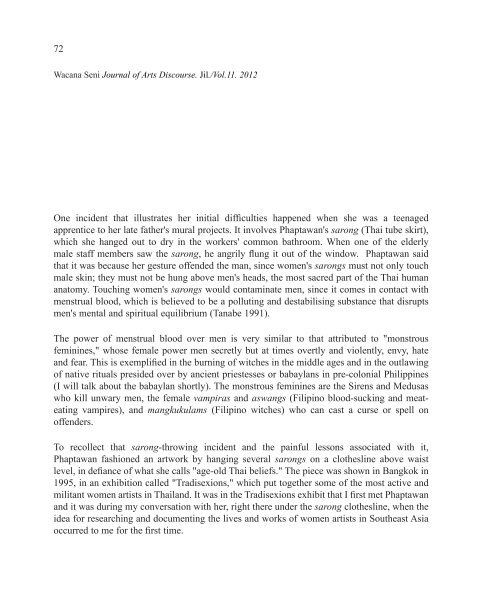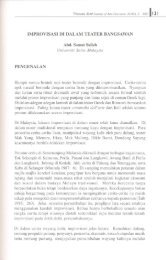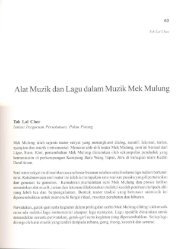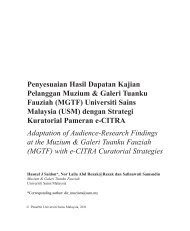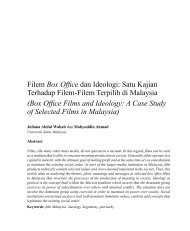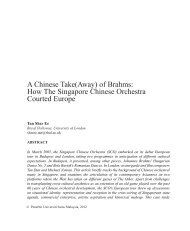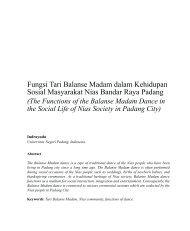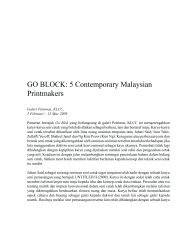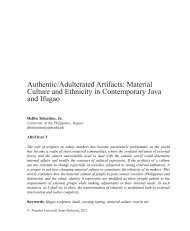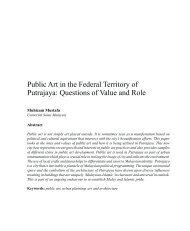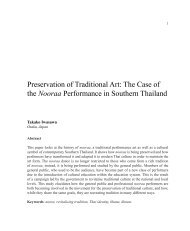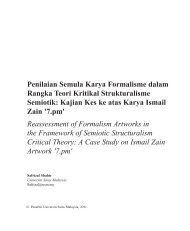Reclaiming The Healing Arts of The Ancient ... - Wacana Seni
Reclaiming The Healing Arts of The Ancient ... - Wacana Seni
Reclaiming The Healing Arts of The Ancient ... - Wacana Seni
You also want an ePaper? Increase the reach of your titles
YUMPU automatically turns print PDFs into web optimized ePapers that Google loves.
72<strong>Wacana</strong> <strong>Seni</strong> Journal <strong>of</strong> <strong>Arts</strong> Discourse. Jil./Vol.11. 2012One incident that illustrates her initial difficulties happened when she was a teenagedapprentice to her late father's mural projects. It involves Phaptawan's sarong (Thai tube skirt),which she hanged out to dry in the workers' common bathroom. When one <strong>of</strong> the elderlymale staff members saw the sarong, he angrily flung it out <strong>of</strong> the window. Phaptawan saidthat it was because her gesture <strong>of</strong>fended the man, since women's sarongs must not only touchmale skin; they must not be hung above men's heads, the most sacred part <strong>of</strong> the Thai humananatomy. Touching women's sarongs would contaminate men, since it comes in contact withmenstrual blood, which is believed to be a polluting and destabilising substance that disruptsmen's mental and spiritual equilibrium (Tanabe 1991).<strong>The</strong> power <strong>of</strong> menstrual blood over men is very similar to that attributed to "monstrousfeminines," whose female power men secretly but at times overtly and violently, envy, hateand fear. This is exemplified in the burning <strong>of</strong> witches in the middle ages and in the outlawing<strong>of</strong> native rituals presided over by ancient priestesses or babaylans in pre-colonial Philippines(I will talk about the babaylan shortly). <strong>The</strong> monstrous feminines are the Sirens and Medusaswho kill unwary men, the female vampiras and aswangs (Filipino blood-sucking and meateatingvampires), and mangkukulams (Filipino witches) who can cast a curse or spell on<strong>of</strong>fenders.To recollect that sarong-throwing incident and the painful lessons associated with it,Phaptawan fashioned an artwork by hanging several sarongs on a clothesline above waistlevel, in defiance <strong>of</strong> what she calls "age-old Thai beliefs." <strong>The</strong> piece was shown in Bangkok in1995, in an exhibition called "Tradisexions," which put together some <strong>of</strong> the most active andmilitant women artists in Thailand. It was in the Tradisexions exhibit that I first met Phaptawanand it was during my conversation with her, right there under the sarong clothesline, when theidea for researching and documenting the lives and works <strong>of</strong> women artists in Southeast Asiaoccurred to me for the first time.


